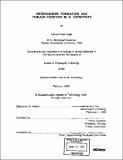| dc.contributor.advisor | Frank Solomon. | en_US |
| dc.contributor.author | Vega, Leticia Rosa, 1969- | en_US |
| dc.contributor.other | Massachusetts Institute of Technology. Dept. of Biology. | en_US |
| dc.date.accessioned | 2006-02-02T18:47:25Z | |
| dc.date.available | 2006-02-02T18:47:25Z | |
| dc.date.copyright | 1999 | en_US |
| dc.date.issued | 1999 | en_US |
| dc.identifier.uri | http://hdl.handle.net/1721.1/31094 | |
| dc.description | Thesis (Ph.D.)--Massachusetts Institute of Technology, Dept. of Biology, 1999. | en_US |
| dc.description | Includes bibliographical references. | en_US |
| dc.description.abstract | Many effectors of microtubule assembly in vitro enhance the polymerization of subunits. However, several S. cerevisiae genes that affect cellular microtubule dependent processes appear to act at other steps in assembly, and to affect polymerization only indirectly. Here we use a mutant [beta]-tubulin to probe cellular regulation of microtubule assembly. tub1-724 mutant cells arrest at low temperature with no assembled microtubules. The results reported here demonstrate that the heterodimer formed between Tubl-724p and P-tubulin is less stable than wild type heterodimer. The unstable heterodimer explains several conditional phenotypes conferred by the mutation. We also describe genes that affect formation of the tubulin heterodimer. Our approach to identify such genes is based on the observation that excess Rbl2p, a ,- tubulin binding protein, is lethal in tub1-724 mutant strains. We show that excess Rbi2p is similarly lethal to cells bearing mutations in CIN1 and PAC2. Genetic and biochemical analysis demonstrates roles for each in heterodimer formation in vivo. Both haploid and heterozygous tub1-724 cells are inviable when, PAC2, is over-expressed. These effects are explained by the ability of Pac2p to bind [beta]-tubulin, a complex we demonstrate directly. And, excess Cin1p rescues the phenotypes of tub1-724 cells, strongly supporting a catalytic role for Cinlp in heterodimer formation. Pac2p is associated with Cinlp and with the tubulin polypeptides. The activities of these proteins in vivo are both similar to and distinct from the role of their homologues in vitro assays for tubulin folding. Our results uncover potential roles for these proteins in catalyzing tubulin heterodimerization in vivo and so in maintaining the balance between individual tubulin polypeptides. Both excess [beta]-tubulin and benomyl lead to loss of microtubules, large budded cell-cycle arrest and cell death. This parallel is supported by the consequences that changes in the level of either Rbl2p or [beta]-tubulin have for both of these microtubule poisons. Overexpression of either gene rescues cells from the effects of 3-tubulin overexpression and confers increased resistance to benomyl. We screened for galactose-induced cDNAs that confer resistance to benomyl in wild type cells. We describe the identification and initial characterization of two genes that allow cells to Live on Benomyl when Overexpressed (LBO). | en_US |
| dc.description.statementofresponsibility | by Leticia Rosa Vega. | en_US |
| dc.format.extent | 215, [33] leaves | en_US |
| dc.format.extent | 12585619 bytes | |
| dc.format.extent | 12618211 bytes | |
| dc.format.mimetype | application/pdf | |
| dc.format.mimetype | application/pdf | |
| dc.language.iso | eng | en_US |
| dc.publisher | Massachusetts Institute of Technology | en_US |
| dc.rights | M.I.T. theses are protected by copyright. They may be viewed from this source for any purpose, but reproduction or distribution in any format is prohibited without written permission. See provided URL for inquiries about permission. | en_US |
| dc.rights.uri | http://dspace.mit.edu/handle/1721.1/7582 | |
| dc.subject | Biology. | en_US |
| dc.title | Heterodimer formation and tublin function in S. cerevisiae | en_US |
| dc.type | Thesis | en_US |
| dc.description.degree | Ph.D. | en_US |
| dc.contributor.department | Massachusetts Institute of Technology. Department of Biology | |
| dc.identifier.oclc | 48167901 | en_US |
